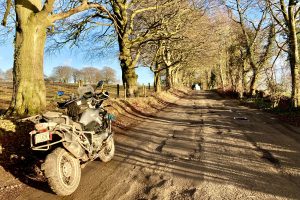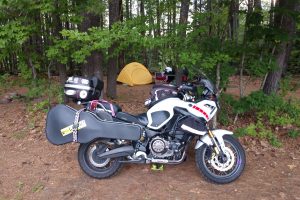By the mid-1990s, the Japanese suits had to be tearing out their hair. They wanted in on that sweet, sweet American cruiser market, but no matter what they tried, Harley-Davidson remained dominant. The Big Four had tried building a more powerful cruiser (KZ900 LTD) and that hadn’t been enough to dissuade the H-D faithful. They’d tried building a better V-twin (the Honda VT750C), and that wasn’t enough either. They’d tried building a wayyyyyy more powerful cruiser (Yamaha V-Max), and that hadn’t worked. What would it take? Why did Americans, and H-D faithful in general, insist on buying dated Harley-Davidson designs?
In 1997, Honda thought it had the solution, with the Shadow 750 A.C.E. This bike was made in America, and it “sounded right.” But, not only was it not enough to torpedo Harley-Davidson’s sales, Big Red actually ended up battling the MoCo over the motorcycle’s familiar exhaust note.

The original Honda Shadow, seen here as the VT700C model. Photo: Honda
The Shadow heritage
Honda’s Shadow lineup started with the VT750C in 1983, and it managed to survive the lean, mean tariff years, when US officials punitively taxed Japanese motorcycles over 700 cc (thanks for nothing, Ronald Reagan!). At the start, Honda had emphasized superior technology (shaft drive and self-adjusting hydraulic valves in the ’83 750 model). Later, it realized that retro was the way to go, not high-tech, and the VT800 headed that direction. Eventually, the VT600C Shadow and VT1100 carried the line, until 1997, when Honda decided to have another go.
本田所做的:大红色的大脑把liquid-cooled VT600 engine (as originally designed for the Transalp!) and bored and stroked it from 583 cc to 750 cc. Like the VT600, the new Shadow 750 A.C.E. had a single, shared crankpin for both pistons. This made one important difference, when compared to older Shadow 750 models: Now, itsoundedmore like a Harley-Davidson. Hit the starter button, and you could kind of potato-potato your way down the boulevard. And, you were doing it on an American-built bike, since Honda built the ACE model in Marysville, Ohio. In North America, the initials in A.C.E. were said to stand for American Classic Edition. Instead of a shaft drive, the 750 ACE had a traditional-style chain drive, and the styling was also straight Americana. In its initial review,Motorcycle Cruisermagazine said “In many ways, we rated the A.C.E. 750 as Honda’s best styling effort to date.”

Back in the 1990s, the aftermarket actually had a decent supply chain for Japanese cruisers like the 750 Shadow, so you could get drag pipes, trick air cleaners or other parts or bits of trim. Photo: The Powersports Store
Meanwhile, there was another story playing in the background, one that’s passed into urban legend. Obviously, the 750 cc tariff hadn’t kept Honda from building a better made-in-America cruiser, so Harley-Davidson tried a new tack in 1994. It went to the US Patent and Trademark Office, and tried to trademark the distinctive Harley-Davidson exhaust note and cruiser styling. Thus began a legal scrap that lasted more than half a decade.
Far as I can find,Harley-Davidson never sued Honda directly; instead, it applied for the trademark, and lawyers from the Japanese manufacturers argued against it. At least, that’sthe LA Times explanation. It ended when Harley-Davidson dropped its trademark application; the LA Times suggested Harley-Davidson was tired of spending money on the legal scrap. Possibly, the Japanese OEMs came to an out-of-court arrangement with Milwaukee? Ultimately, maybe everyone realized that while Honda had come pretty close to nailing Harley-Davidson’s formula, it still wasn’t enough to fool the faithful. The Hells Angels weren’t about to buy a Shadow 750 A.C.E.
The Shadow 750 A.C.E. today
Honda sold an awful lot of Shadow 750 A.C.E. models during its production run, and thanks to its excellent engineering and build quality, many of them are still on the roads. And, let’s be honest: This heavy, low-slung cruiser with 43 horsepower at 5,500 rpm and 44 pound-feet of torque at 300 0rpm did not lend itself to aggressive hoonery. It attracted a mature, responsible buyer; bad boys wanted a Harley-Davidson, and if they couldn’t afford that, they bought something cheaper than the Honda (a decrepit old Virago, most likely). The Shadow 750 A.C.E. ownership kept their bikes in good nick, with lots of washing and fettling. They kept their bikes in a heated garage, and changed the oil on schedule.
That means the Shadow can be a good buy today, if you’re looking for a reliable cruiser on a budget. The fasteners shouldn’t be rusted tight, and if you do have to perform a bit of maintenance, there’s minimal pesky bodywork to remove. Older cruisers like this are almost as easy to wrench on as a dual sport, which is certainly worth a consideration if you’re buying second-hand (or by this point, the bike may be third-hand, or fourth-hand).

Is $3k too much for a 23-year-old Japanese cruiser? Maybe not, in these COVID times. Photo: The Powersports Store
The bike in the photos here is listed for $2,999 at The Powersports Store in Cincinnati, Ohio. That might be a tad on the high side, pricewise, but COVID-19 has driven prices up, and besides, if it’s at a dealer, you should be able to buy with some manner of confidence. It would be nice to see a set of saddlebags with the purchase, but at least you get stereo speakers, a windshield, floorboards, highway pegs, engine guard and a fancy two-up seat, if that’s your thing. If you think this might suit you (it would certainly be a cost-effective commuter or even a touring bike), you can find more details at the dealer’s websitehere.
For inmates’ perspective, see the Honda 750 Shadow threadhere.







